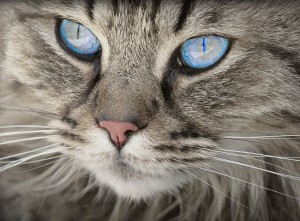 It’s not surprising that scientists conduct more behavioral experiments on dogs than on cats. Believe it or not, there are groups and conferences dedicated to the understanding of our canine companions. However, since our favorite felines tend to be less cooperative and more skittish than dogs in social situations, it’s more difficult to study them in cognitive experiments and gain a deeper understanding of how they think. But, thanks to a recent paper released from the Oregon State University based on study findings on felines, we now know just a bit more about what’s going on inside a cat’s head.
It’s not surprising that scientists conduct more behavioral experiments on dogs than on cats. Believe it or not, there are groups and conferences dedicated to the understanding of our canine companions. However, since our favorite felines tend to be less cooperative and more skittish than dogs in social situations, it’s more difficult to study them in cognitive experiments and gain a deeper understanding of how they think. But, thanks to a recent paper released from the Oregon State University based on study findings on felines, we now know just a bit more about what’s going on inside a cat’s head.
Perception. Understanding cat perception ~ their ability to see, hear, smell and detect stimuli ~ is important because it provides clues on how cats perceive the world around them. For example, a cat’s ability to smell is particularly important to kittens, as they don’t have the ability to respond to sound until they are approximately 16 days old, and their ability to respond to sight doesn’t begin until approximately 21 days old. And scent cues are highly important to a cat throughout his life, as adult cats use their sense of scent to mark their territory, and to smell the territory of other cats. They also use scent to collect information on other cats.
Object Permanence. This is a cat’s ability to “keep in mind” and object, even after it leaves a cat’s view (just as we humans can recall the appearance of an object in our minds after we no longer see it). Anyone who has ever placed a can of tuna on the counter, out of their cat’s sight, and witnesses Fluffy staring upward, knowing the can is there, understands cats have object permanence. Even more interesting, cats can not only keep an object in mind when it is no longer visible to them, but they can also reason about where it may have moved.
Physical Causality. So, do cats understand physics? Do they understand how objects in their world relate to one another? One study attempted to address these questions by giving cats the opportunity to tug on bits of string in order to access food. Some of the string was attached to food in a way that “made sense” (for example, the food was tied to the end of the string with no obstacles), while other pieces of string were laid horizontally to the food, or crossed over in a manner that did not make sense. Cats pulled on the strings indiscriminately, not seeming to understand any reasoning behind their actions.
Quantity Discrimination. This area has been researched very little, but it has been found cats can be trained to discriminate between two dots and three dots, indicating they can indeed tell the difference between quantities (at least in small amounts).
Social Cognition. Many of us think of domestic cats as independent, solitary creatures who choose to “hang out” with their humans. Their known for their finicky nature, and their interactions with us can range from aggressive to indifferent. Cats generally learn to socialize with other cats and with humans within their first two to seven weeks of life. Generally speaking, kittens who are exposed to more people during this critical period will grow to be friendlier toward humans as they age.
Indeed, cats are complex, sometimes misunderstood, creatures. But, hopefully with more studies like that from Oregon State University, we’ll soon have more insight in to what exactly is going on in their cute little heads!




